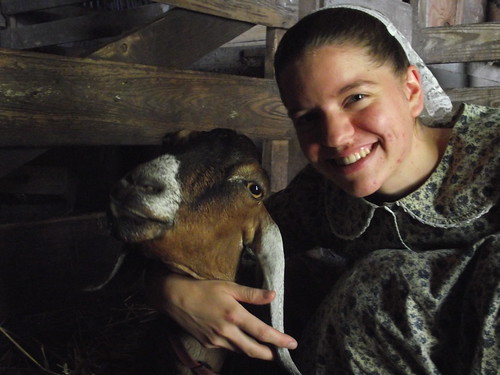
Now we come to the second “R” of academics–wRitin’. (I’m talking about writing to express yourself, vs. handwriting.)
Of the 3 Rs, this one is the most fun, and yet can seem to be most intimidating to “teach”. It can be as easy or as hard as you make it, really.
Now, language arts is my “thing”. It might not be yours, but I am going to share some things with you that will help demystify teaching writing.
What is the reason to learn writing? It’s to be able to express yourself. Please keep in mind that not everyone needs to know how to write a short story–or a research paper. For some, being able to write up a quote for a job and maybe a love note to a wife may be all the “writing” they really need! As in all of education, having a “one-size-fits-all” attitude is not going to work well here. You may have some children who are trying to write their own novels at 9 and others who seem allergic to anything to do with the subject! The first axiom in teaching writing is, Know whom you’re teaching and why.
I have daughters who love to write more prosey things and stories, and I have one that is “Just the facts, Ma’am!”. I have another who thinks she doesn’t like to write, but if you let her do it with the computer vs. pen and paper, does very well. Had I insisted they all write short stories and novels, or had I insisted they all do research, had I insisted they all use pencil and paper, I would have killed any love of writing in my four oldest daughters.
There are some things I could have done better, don’t get me wrong! But overall, I’m going to share some very simple ways to teach writing as well as some resources I like.
Teaching to write is as simple as writing a letter. Really! The “program” I used with my two oldest was Understanding Writing by Susan Bradrick (here is another review, by Cathy Duffy, and here you can get information directly from Family Discipleship Ministries, the Bradrick’s ministry). It was the best investment I made!
Basically, you are teaching writing through the medium of writing letters. Mrs. Bradrick teaches how to evaluate your content and focuses on Christ-honoring writing. Grammar is sprinkled in throughout level 4 and up (levels do not necessarily mean grade level), and she advises taking the “junior high” years to study grammar using Easy Grammar, while reviewing and honing skills learned in levels 1-5. I admit right here that we tried Easy Grammar and I thought it was an overkill. But I have an aversion to workbooks of just about any stripe! LOL!
I “taught grammar” in context. Mrs. Bradrick has you using grammar handbooks, and although you might occasionally need to work on a concept, my oldest two daughters really absorbed a lot this way. They might not know all the “grammar terms”, but they have proven Ruth Beechik right in that they write beautifully! By the way I highly recommend first reading everything Ruth Beechik has to say about teaching grammar before you stress about it! ![]()
Understanding Writing is not something you can just give to your child and they do with minimal input from you. The lessons are well-laid out, not twaddly, and really fairly short. Older children could possibly read it and do the lessons on their own, and sometimes I “doubled” up–while practicing a concept by writing a letter, I would sometimes teach another lesson (depended on what the next lesson was and my daughters’ ability to absorb something new while practicing the previous concept).
The most wonderful part, to me, is that this becomes a ministry! One of my mother-in-laws lived out of state and loved getting letters from her granddaughters! We had a neighbor who was dying of cancer, and one of my daughters wrote her a few times before she passed away. She had told me how much those letters meant to her.
Shut-ins, grandparents, neighbors, friends far away–what a beautiful way to keep in touch!
It’s also nice that there is a purpose to writing vs. filling in a workbook that only Mom is going to see.
My girls would make a copy of their final letter to keep in their folder before sending the original off.

Another resource I’ve used is Jill Bond’s “Writing to God’s Glory“. The first part is for the “teacher” or, if it’s an older student, the student could read this part. Jill helps get you focused on using your “red pen” for highlighting all the good stuff, vs. marking up what’s wrong with a child’s writing! Again, this is not a “pull it out and hand it to your child” resource, but I personally found it good! I did some of the activities in the “teacher section” with my oldest two, then life took over and I just let Jessica finish it on her own. It’s supposed to take 2 years to work through. I honestly don’t remember how long with Jessica–we think it was longer.
Some don’t consider this an “in depth” program, but I know I am writing to many young mamas of many. To be honest, if your older child is really into writing and needs something more “in depth”, then by all means find what will work for them! But I will tell you that Jessica got started on a sweet children’s character novel simply by the section that had her coming up with a plot, characters, etc. for a story!
It’s considered K-12, with older students able to go through it on their own (although some feedback from you would be nice!).
Writing Well is the first section, talking about the process (mechanics of building a story) and the features (aspects of writing). The Craftsmen section is grammar, although again, not an in depth treatment of it (not all bad!). Jill makes it really fun with titles like “Gotcha (“Got” Is Not the Past Tense of “Have”)” and “Love is Lovely” (Overuse of words). Ideas is the section that has you coming up with a plot, developing characters, setting and research for a book. Note–you do not HAVE to write a book! But by going through those processes, you get an idea of what plot, setting and character are!
Finally is the “Favorites” section, where students will write down favorite things they like in others’ writings. First lines. Vignettes.
Jill gives a couple of “scope and sequence” ideas for working through the book.
Because I have “different kinds of writers” in this family, my third and fourth daughters did not enjoy this as much. So the hunt was on, again, to find something for them!

I latched onto Diane Hopkins’ Journal and Language Arts Program, from Love to Learn (K-5). About half of this binder is filled with papers with different sized lines for writing, with the front page half blank for a drawing. The idea is that the student draws a picture and “journals” on the lines. You don’t “grade” their spelling or grammar, although you should encourage good handwriting, you don’t “grade” that either.
Spelling grows out of their journaling, and she has spelling list pages that you can keep track of the words they need to “study”, gleaned from their writing.
Next is the “Teach When Needed” Language Arts section! She has some ideas by grade level (nothing daunting–it all fits on one page!). Then there are ideas for lessons on everything from Abbreviations, ABC Order, Addressing an Envelope to Prefixes, Suffixes, Roots, Punctuation, and Synonyms (there’s more than just that, but I wanted to list some to give you an idea). There are even some spelling families listed.
The final section is Dictation Instructions, along with four sections of quotes of various lengths to use for dictation. This was very gentle and worked well for us for awhile. Again, to be honest, no, I did not do everything all the time. But it was a sweet, non-threatening way to get them journaling. They kept their work in a binder, which is funny to go back through now!

We found Sandi Queen’s Language Lesssons series at Queen Homeschool Supply (K-12), and because life had gotten a bit insane for us, they were an answer to prayer! These are more like traditional workbooks EXCEPT—they are based on Emma Serl’s Language Lessons and are definitely Charlotte Mason and relaxed schooling friendly! Short, sweet lessons, picture studies, grammar, writing, phonics for the younger set (although not enough to get them reading–but good review), and poetry. My girls really like these. When Susannah and Cassia got to the upper levels, they didn’t care for them as much, but neither of them are prosey fiction writers, and there was more writing at those levels. I also would say the copywork is maybe a bit overdone sometimes, but that is probably because my children copy daily from the Bible. So I sometimes excused them from some of the copywork. I realize copywork is GREAT to teach handwriting and other skills, but use your discretion on this (if you have one with an aversion to pencils, maybe you would cut down how much they did).

The resource we started using last year is Andrew Pudewa’s Teaching Writing: Structure and Style. I only have the teacher’s syllabus that I’m teaching from, although I have viewed the dvds as well. With the dvds you have a very comprehensive course on writing. I’m not very qualified to tell you how it all fits together, but you do not have to buy the student dvds. Since I have seen some of the dvds, heard Mr. Pudewa speak and like language arts myself, I am fine using just the syllabus. It is definitely a more expensive option if you go with the dvds, but many homeschool groups have invested in some to share or a mom who had been through them may teach at a co-op. I really like Mr. Pudewa’s teaching and he makes it “easy” to write–I was teaching my 9, 11, 12 and 16 year olds, and the 18, 21 and 23 year olds want to be in on it, too! My one daughter who really dislikes writing the most actually enjoyed it, and my friend who is loaning it to me said her older son is in college and writing essays very well. Her younger son is severely dyslexic, and HE enjoys them! That says volumes!
I need to say that they don’t advise teaching it without going through the course. Of course, I have to be different! ![]() I had borrowed this to see if it was worth investing in, and I believe it is. So I will probably be getting my own set of dvds and syllabus this fall.
I had borrowed this to see if it was worth investing in, and I believe it is. So I will probably be getting my own set of dvds and syllabus this fall.

I realize all of these require a bit of investment. To be honest, if you are willing to go against the flow, you can teach a lot with Ruth Beechik’s recommendations in her books (A Strong Start in Language–good for K-3, and You CAN Teach Your Child Successfully–grades 4-8). Another really good resource that is helpful, free, and not too overwhelming (as long as you don’t keep reading all the rest and feel you have to add it in) is “Making the Transition” at Simply Charlotte Mason. You don’t even have to be a “Charlotte Mason” homeschooler to use these ideas!
The page I linked to first is “stage 1″, basically talking of short lessons, living books and narration. For younger children, that plus copywork is really all you need! But if you want to know more, click here and scroll down a bit for spelling ideas, and click here for ideas on language arts. But don’t try to do it all at once. “Make the transition”, as it says!
I am mainly covering writing as expressing yourself, vs. grammar and spelling. I will cover them in wRitin’ part 2 in two weeks! It will be a MUCH shorter post, believe me! ![]()
If you have any questions about the resources I’ve used, or if you want me to clarify anything, feel free to ask in your comments or e-mail me. I really love language arts and want to get back to having fun with this with my younger set!
The bottom line is—don’t stress and have fun! Teaching “as you go” is one of the best ways—and it works! ![]()

Tags: 3 Rs, Fabulous Family Friday, language arts, resources, Ruth Beechik, writing